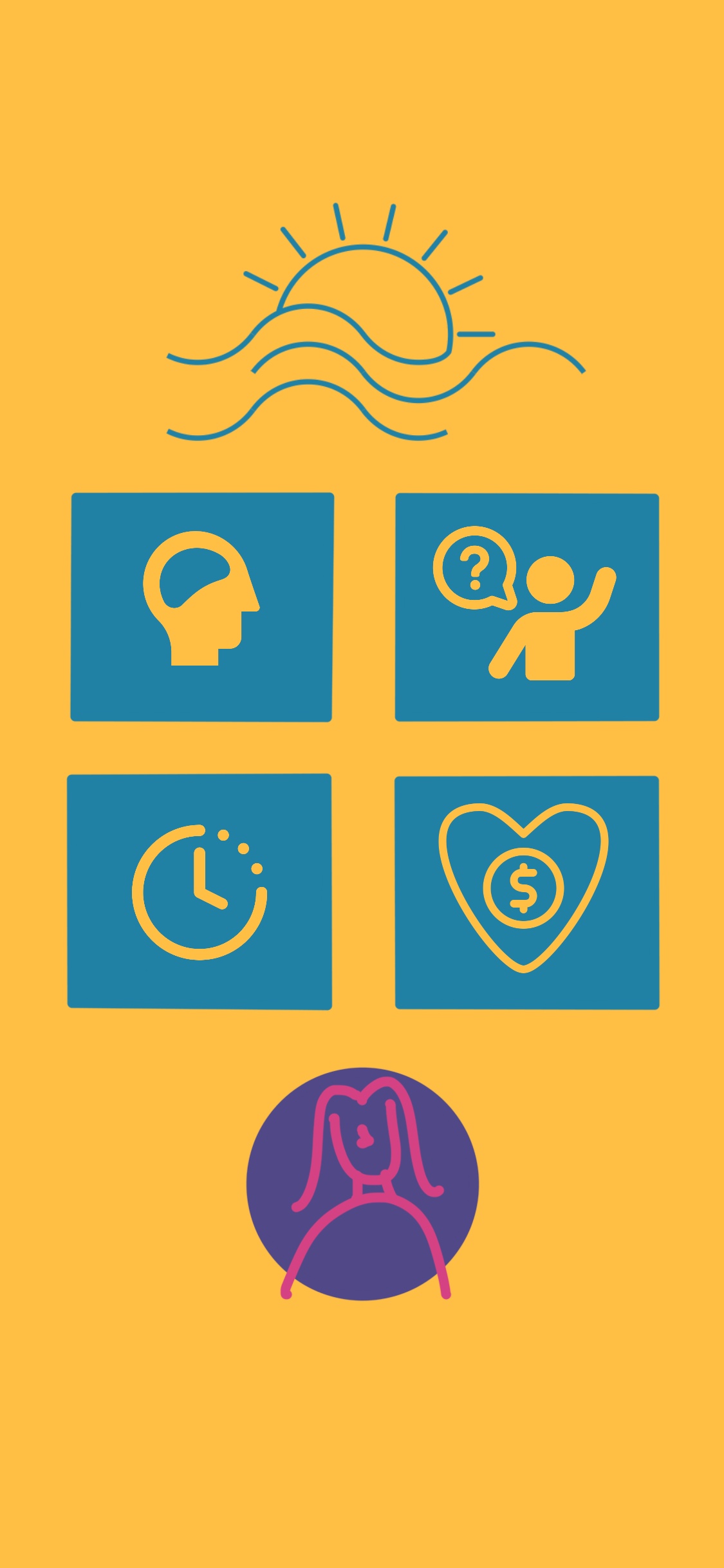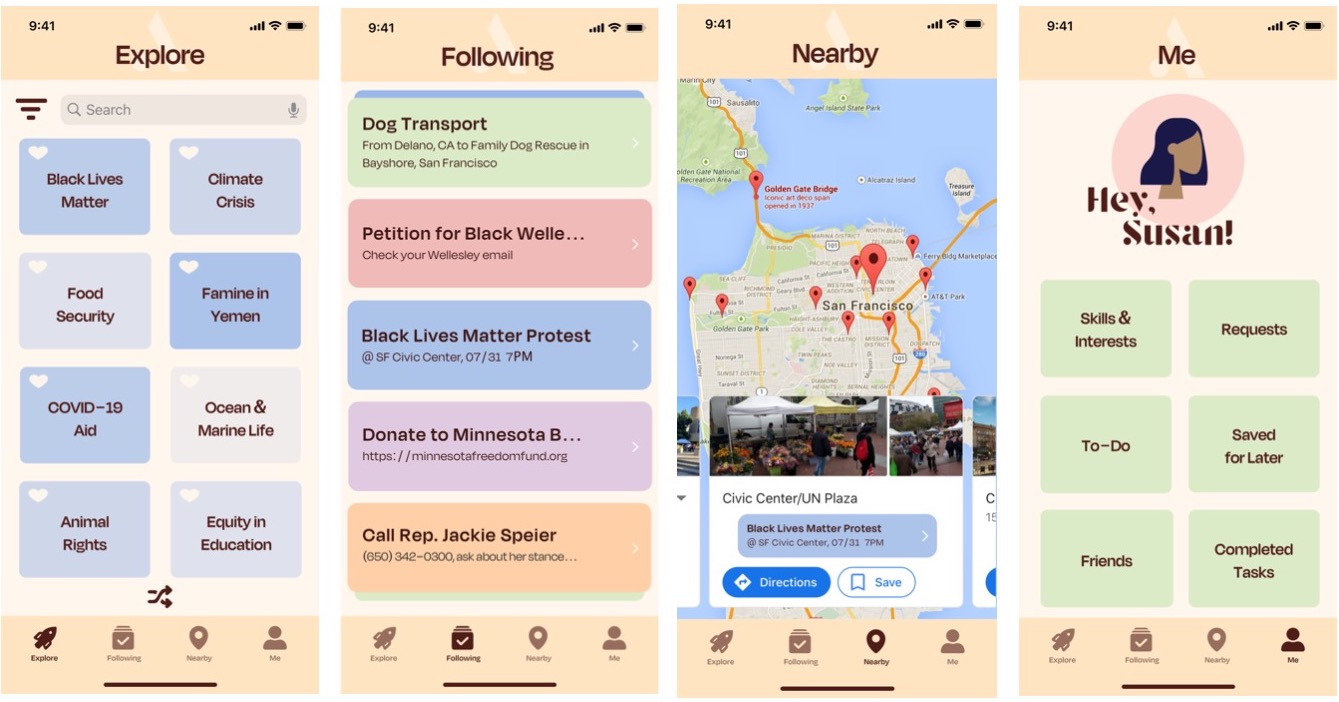Actvism & Community
Learn More!

ActOut
Team members:
Yasmin Afifi, Clara Kim, & Kathryn Swint
Problem statement:
Our mobile application seeks to connect people who need help and who want to help with activism work while compiling, organizing, and fact-checking information and needs from diverse groups. We would like to create a platform in which users can actively engage by posting and signing up for requests. Our app will verify user identity, protect private information, and allow users to create social and geographical community groups while doing activism work. We hope that this application will initiate small acts of kindness and provide physical and emotional relief during this time.
Interviews & Personas
Our first interviewee was an 18 year old high school graduate on a gap year before heading to a liberal arts college in the Northeast in the fall. Her mom works as an immigration attorney, so User 1 has spent much of her life adjacent to professional activist work. She has experience organizing within her community and had been putting her time towards helping with Black Lives Matter protests. She felt frustrated that her knowledge, resources, and connections weren’t being used as much as she felt they could be. User 1 knew there were a lot of talented, passionate people who could make a difference if they knew where or how to help. She felt like she saw two halves of a bigraph, with “needs” being met if and only if they went viral on social media, and with activists putting resources to needs they saw online instead of needs they might be uniquely situated to help with.
User Interview 2: was a college student in Minnesota who started getting involved with activism after the murder of Philando Castile in 2016. She cares deeply about preventing climate change and the Black Lives Matter movement and enjoys the work she puts into the movements, but she also feels like the burden for change is placed too heavily on activists her age and activists of color. She has been excited about the change she’s seen as a result of activism, but she is always wondering if she’s doing enough. She loves how social media provides an easy way to broadcast information to a large audience and the crowdsourced nature of the platforms. She’s frustrated with misinformation and trolling, and has found that online activism hasn’t worked as well and that the COVID-19 crisis has really stunted activism in 2020.
Interviewee 3 was a college student studying political science. She was back home for summer break and noticed that internal racism exists within the Asian community after talking to some of her friends. She decided to create an Instagram account after identifying the need to demystify anti-blackness on a personal and familial level. She collaborated with her illustrator friend to make easily accessible graphics and used hashtags to spread the information. She wished that she could get help with translations and fact-checking for accuracy and inclusivity.
Users who had had extensive experience with activism work expressed the need of more time and efficiency. They claimed that they spent a lot of time looking for desired resources/help and wanted a readily accessible resource bank. On the other hand, users with little to no experience often got frustrated by the lack of compiled resources. They couldn’t easily identify how they could help besides educating themselves or donating.

Lila, 18, is a recent high school graduate on a gap year before heading to their liberal arts college in New England. Her mom is an immigration attorney who spends her free time working cases pro bono. Lila’s parents both immigrated to the U.S. in the 1980s, and her family’s experience with immigration and activism informs how she spends her time. Recently, Lila and her sister have spent lots of time attending protests supporting Black Lives Matter in San Francisco and Oakland, but Lila is frustrated because she feels like she could be doing more. Her mom’s connections and resources don’t seem to be doing as much good as they could. Lila wants to figure out how she can contribute to causes she cares about while balancing her time with work and helping her sister with school. With the new school year starting in two months, Lila feels the time crunch.

Sarah, 20, is a sophomore in college studying environmental science. She is excited to be focusing on the issues she cares about and spends a lot of time on student organizations raising awareness for issues. She thinks that the best way to create real change is to reach out to politicians and gather support online through petitions. She spends a lot of her time finding petitions to sign and testing politician phone numbers and sending emails voicing her concerns. Sometimes she feels like there is so much out there to sort through and this takes up alot of her valuable time that could be more effectively spent actually taking action.

Susan is a middle-aged accountant living in the Greater Los Angeles area. She recently got interested in activism work because her daughters started having such conversations at home. She doesn’t understand why activism is so important and gets frustrated because she is unsure what to trust on the Internet. She doesn’t have much time on her hands, so she wants to help with her fiscal resources if possible.
Plan 1: Do 1.1, 1.2, 1.3, and 1.4 in that order Plan 1.1: Do 1.1.1 and 1.1.2 in that order Plan 1.2: Do 1.2.1, 1.2.2, or 1.2.3 in any order Plan 1.2.1: Do 1.2.1.1, 1.2.1.2, or 1.2.1.3 Plan 1.2.2: Do 1.2.2.1 or 1.2.2.2 Plan 1.3: Do 1.3.1 and 1.3.2 in that order. 1.3.2 is optional but recommended. Plan 1.3.2: Do 1.3.2.1 and 1.3.2.2 in that order Plan 1.4: Do 1.4.1 and 1.4.2 in that order Plan 2: Do 2.1, 2.2, 2.3, and 2.4 in that order Plan 2.1: Do 2.1.1 and 2.1.2 in that order Plan 2.2: Do 2.2.1, 2.2.2, 2.2.3, or 2.2.4 based on 2.1 Plan 2.2.4: Do 2.2.4.1, 2.2.4.2, 2.2.4.3, and 2.2.4.4 in that order Plan 2.3: Do 2.3.1 if necessary Plan 2.4: Do 2.4.1 and 2.4.2 in that order, and repeat 2.2 and 2.3 as needed Plan 3: Do 3.1, 3.2, or both Plan 3.1: Do 3.1.1 (optional) and 3.1.2, 3.1.3, and 3.1.4 in that order Plan 3.1.1: Do 3.1.1.1 or 3.1.1.2, not both Plan 3.1.1.1: Do 3.1.1.1.1, 3.1.1.1.2, or both Plan 3.1.1.2: Do 3.1.1.2.1, 3.1.1.2.2, or both Plan 3.1.2: Do 3.1.2.1 then do 3.1.2.2 and 3.1.2.3 as needed Plan 3.1.3: Do 3.1.3.1 and 3.1.3.2 in that order Plan 3.1.3.1: Do 3.1.3.1.1 Plan 3.1.4: Do 3.1.4.1 and 3.1.4.2 in that order Plan 3.2: Do 3.2.1 and 3.2.2 in that order Plan 3.2.1: Do 3.2.1.1 and 3.2.1.2 in any order Plan 3.2.2: 3.2.2.1 is optional.
College students, professional activists, vulnerable populations, community organizers, medics, etc.
Google Docs with compiled information, non-profit organization websites, mental health resource/ reference websites, GoFundMe pages, YouTube videos, petition pages, etc.
Google Docs, GoFundMe, YouTube, social media (Instagram, FaceBook, Twitter), etc.
books, cars (for driving), donation items, etc.
Scenarios, Designs, & Review
Scenario:
You are a sophomore at Wellesley College studying Political Science. You are currently back home for the summer and have been working on your internship with the political science department. In lieu of the recent events in Minneapolis, you feel motivated to organize a Black Lives Matter protest in the San Francisco area and would like to get the word out among like-minded people. You know a lot of people in your age group (your high school friends), but not too many in other age groups. You have made all arrangements for the protest and would like to get as many people as possible to participate.
Videos, Designs, & Reviews

Red Design Rationale:

Yellow Design Rationale:
After getting multiple concerned feedbacks, we limited the social aspect to discourage performative activism. We also got rid of the learning feature in our earlier iteration to focus on connecting the “helpers” and the “help-needed.” We wanted to encourage the users to take action without pressuring them, so we combined muted tones with warm, energizing colors. We used large icons, labels, and buttons to make our app accessible to a wide range of users.
The Explore page is the general directory for finding requests. This page contains buttons for different causes; to avoid creating any type of implication or priority set by developers, we added a shuffle icon for topic order. As the label implies, this page allows users to explore topics they were not aware of as well as ones they were already interested in. When the user chooses one of the causes, they will see the type of help they can offer, then a list of tasks to select from.
The Following page was inspired by TikTok (a popular social media platform)’s For You Page. This page lays out a list of tasks generated by the user’s past activities and interests. We created a page optimized for quickly completing simple tasks when the users do not have too much time on their hands.
The Nearby page provides an alternative way to look for and complete requests. The user can see nearby requests and sign up for off-line requests if they are willing and able to do so.
The Me page can be personalized and encompasses all information about the user, from signed-up tasks to friends, skills, and interests, the user can easily keep track of how much they have contributed to activism work. This page also includes a to-do list for current tasks and a button for saved tasks.
